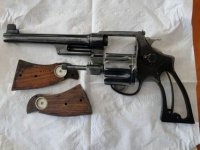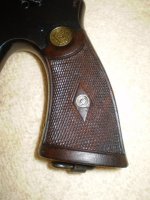Grandpa Si
Member
- Joined
- Aug 15, 2010
- Messages
- 13
- Reaction score
- 2
I recently inherited a S&W New Century Triple Lock revolver in .44 Spl made in 1918. It shoots great with one exception. There is a small raised ridge in the metal next to where the firing pin comes through the frame. That ridge hits the base of the cartridge case as the cylinder rotates. Sometimes it won't allow the cylinder to rotate. I don't know if this is an ammo problem (base of the cartridge case is thicker than they used to be) or a revolver frame problem (the raised ridge is mfg defect or an obsolete feature and needs to be ground off). I have not yet tried multiple types of ammo to see if a different make of ammo allows the cylinder to turn.
Any ideas or seen this before?
Any ideas or seen this before?


